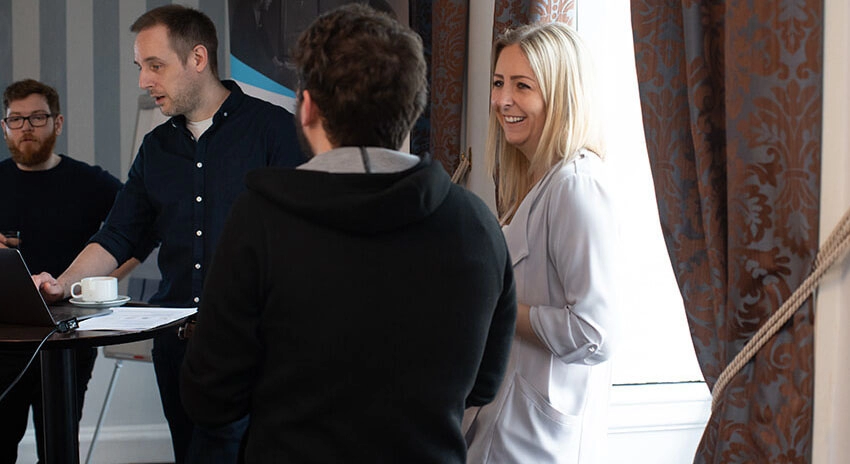What is Google Analytics?
If you’ve ever wondered what ‘bounce rate’ means, or what a ‘session’ is, or aren’t sure of the difference between a 'page view' and a 'unique page view', then say hello to Google Analytics. Blue Frontier’s Charlie Regnart treated an audience at the Dolphin Hotel in Southampton to a gentle introduction to the world of Google Analytics in the latest Go!Digital event, explaining why this tool should be front and centre of their online marketing strategies.
Imagine a customer walking through your front door and before they even have to speak a word, you know their demography, their interests and their hobbies. Then imagine that you’re able to predict the next step in their journey after as little as one interaction. Google Analytics provides businesses with in-depth knowledge of user behaviour that can be used to optimise things like their website’s structure and content to improve the users’ experience.


How does it work?
Google Analytics is a free tool that provides businesses with a wealth of insightful data about users’ activity on their website. Websites sit at the heart of most digital marketing strategies so this data is invaluable, and is essential in helping businesses get to grips with the user journey. It also enables businesses to make informed decisions on how they can improve their website to deliver a better user experience.
At a basic level, Analytics shows you the number of people visiting your website and how they got there. On a more complex level, Google Analytics can show the percentage of website visitors that convert into customers, and where those customers are coming from - this information can help decide where to invest your marketing budget.
If you’re a new business looking at analytics for the first time it can be quite daunting. There’s a load of useful data there. To have someone show you how to set it up and start analysing data is invaluable. We help set up Analytics for companies and get involved at whatever level companies need. This could be running a workshop like the one here today, or it could be training people how to use it, or on a higher level, actually taking charge to assist our clients to make essential changes to their websites and create a richer experience for their users.

A closer look into data
The theme of the Go!Digital workshop is to create a relaxed environment and allow anyone participating to feel they can ask any question they need to. Attendees followed the briefing using their laptops, so that they could view their own Analytics data, while Charlie covered as much ground as the hour allowed. As well as following the data, participants could also take a handy written briefing away with them.
The session started with an initial overview of Analytics, discussing the importance of setting up your account correctly from the outset. Part of this is following Google’s best practice, like having different views and applying filters correctly so your data is as accurate as possible. An important factor for monitoring how users engage with your site is Goal Conversion tracking. Goals should relate to key business objectives. If you’re an ecommerce site, then you want to know about transactions. If you’re an information site, you’ll want to create goals for lead generation, like setting up a contact form.

The session continued as Charlie went through the types of reports most commonly used in Analytics. The dashboard is set up so that you can access the main reports from the left side menu while the data is visualised in tables and graphs on the main page.
Audience reports give you detailed insights about your users, including things like their location, language, age and the tech that they’re using. This information helps you to understand your user’s and how you can improve your site to deliver a richer user experience. In the age of mobile-first indexing, the 'Devices' report can give you detailed information on the performance of your site on mobile devices.
The 'Acquisition' report reveals what drove users to your website. This can help businesses identify which their most effective marketing channels are. Whether they came via social media or a PPC campaign. You can see what marketing channels work for your business and where you need to improve.
Behaviour tells us the pages which consistently gather the highest views, your most popular landing pages, and just as importantly, the pages that most people exit from. By drilling into individual pages of your site, you can see the best (and worst) pages for user engagement and conversions, so you can see what’s working and what needs improvement.
How to get started using Analytics
Taking the time for companies to familiarise themselves with their Analytics data may be overwhelming at first, but there’s so much interesting data to help users understand the way in which their users interact with the businesses website.
Charlie added,
It’s great to be able to see how your marketing campaigns are working and you wouldn’t know this without Analytics.
Google offers free courses in Analytics and we’d recommend you try them: https://analytics.google.com/analytics/academy/

If you’re just starting out, Google Analytics for Beginners will give you a basic understanding and allow you to gain useful insights into your website and users. Already an Analytics pro? There’s also an Advanced Google Analytics course and Google Analytics for Power Users for those of you with a bit more experience. Alternatively, speak to a member of our Digital Marketing team for analytics advice.






